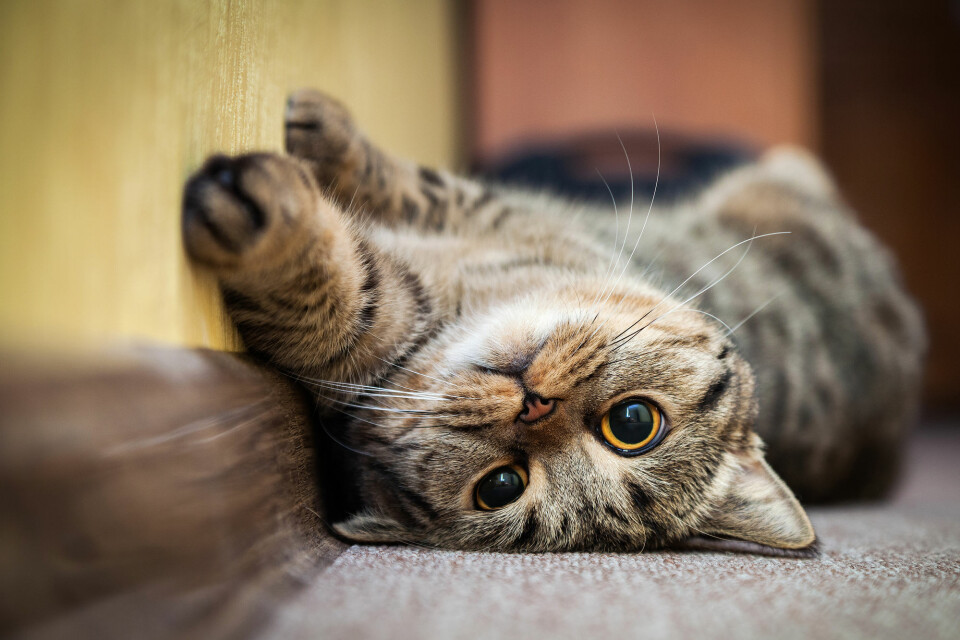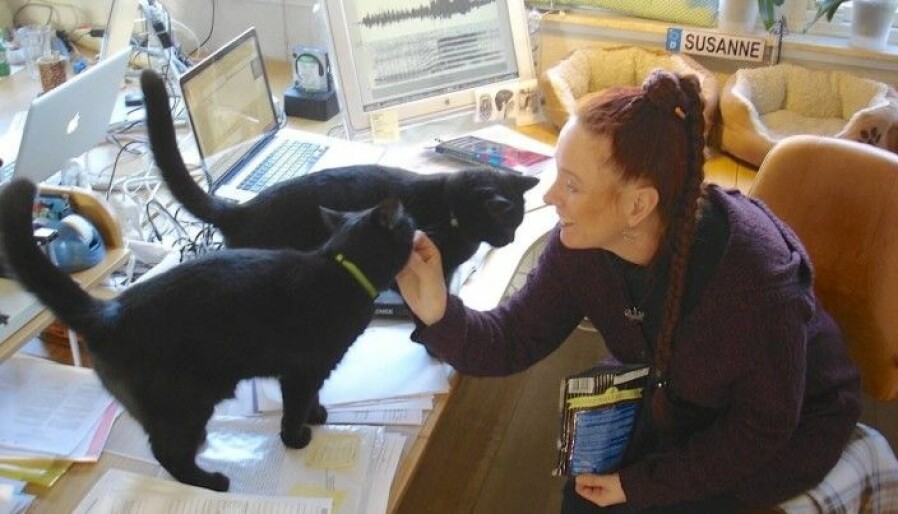
Your cat meows mostly for you
Cats don't often meow to other adult cats, but they quickly learn to use sounds to talk to humans.
When cats encounter each other, they rarely use typical meowing sounds to communicate. Towards humans, on the other hand, cats are generous with their vocalizations. They use their voice to tell us what they want, how they feel and just to say "Hello, good to see you!" How did they pick this up? And why do we like to talk back to cats in a higher-pitched voice?
Professor Bjarne O. Braastad at the Norwegian University of Life Sciences (NMBU) is the person to go to in Norway if you want to understand cat behaviour. He explains that meowing consists of instinctive sounds that kittens use to communicate with their mother.
“Mama cat and her kittens meow to each other. When a kitten goes to a new home, it will try to use the same sounds with its humans,” Braastad says.
If the kitten senses that we’re responding, it continues talking.
“But if we ignore the cat's meowing then it eventually stops, because it realizes that humans are stupid animals that don’t understand them,” he says.
Act like babies
So when cats meow at humans, they’re using what were originally kitten sounds, and this is pretty typical behaviour for various domestic animals,” says Braastad.
“Animals that live with humans tend to use their baby behaviour towards humans because they find that it works. But they don’t use the same behaviour towards other adult animals of their own species,” he says.
Although cats don’t vocalize with each other in the same way they do with humans, they do use sounds. Male cats may howl to scare off a rival. Female cats that want to mate can call in a male. And cats will hiss or growl when they feel threatened or aggressive. Body language and touch are other equally important forms of communication.
Susanne Schötz agrees. She is a linguist and teaches phonetics at Lund University in Sweden. On the side she researches cat language.
“When cats are young and living with their mother, they meow a lot when they need help or attention. I think many adult cats retain this attribute, so they behave almost like kittens when they’re with people. They meow for attention.
And this is usually pretty effective with their humans,” Schötz says.
“We respond very quickly and strongly to the sound frequencies cats use. These are some of the same ones humans use when we’re tired or need help, so we’re very sensitive to the pitches of cats’ meowing.
A long partnership
Cats are independent. They do pretty much as they please, but humans and cats have had a close relationship for a long time.
Cats probably started to keep company with humans as early as 10 000 years ago, when humans started growing cereals. Rats and mice enjoyed themselves in the grain stores, and that attracted wild cats. The farmers probably thought it was good to have cats nearby that kept the rodents at bay.
Cats are not that genetically different from the wild cats they originated from and were not tamed in the same way as dogs. Some researchers believe that cats tamed themselves by choosing to live close to humans.
Demand and pleasure vocalizations
Meowing by adult cats is a language specifically intended for humans.
But we’re not always very good at distinguishing the meanings of different vocalizations, Braastad says. A meow isn’t just a meow - it can hide nuances that can mean vastly different things.
“One way to discern the meaning is to notice which part of the meow (or miaow) vocalization the cat stresses,” says Braastad.
The m- or mrr-sound is a pleasant sound that the cat uses for people it likes.
“It’s a greeting to connect, and it can also be used to display social relationships. That’s what my cat says when it comes onto the bed at night – the cat says mrr, I answer mrr and then we go back and forth a little bit.
Mama cat also use this sound for her kittens when she comes home.
If the e of the meow is stressed, it can signal physical discomfort, such as that the cat is hungry or cold.
The meow that cats use most with humans has a long ah-sound.
“That’s the cat’s way of demanding something,” says Braastad.
“When the cat doesn’t get what it wants, it meows with a longer and longer ah so that eventually it becomes a me-ahh-ow. The longer the ah-sound, the more insistent the demand. Then you know the cat really wants something from you.
If the person doesn’t respond, the cat becomes frustrated and the ow-sound becomes more pronounced, almost like a howl.
"Me-oww?"
It's not just the vowels in the meow that vary. Inflection matters, too.
As a linguist and phoneticist, Susanne Schötz tends to listen carefully to nuances and inflection in spoken languages. She couldn't help but listen with her “researcher ear” whenever she heard her own cats meowing upon her return home.
She is now well underway on a five-year project researching cat language with two colleagues. They have filmed and recorded the sounds of 70 cats and their owners in many different situations.
“We’ve confirmed that there’s a lot of variation in the melody of cats’ vocalizations. If you listen to their inflection, or melody, you may understand the cat a little better.
The researchers have found that in positive situations, such as when the cat is anticipates being fed or wants to play, the pitch of the meow rises at the end.
“If I want to mimic a positive meow, then I say ‘me-ow?’ with a higher pitch at the end.
The melody is similar when humans ask a question.
A negative meow drops in pitch towards the end, like a "meowu..."
- RELATED: One of our partners, the University of Oslo, have written a piece on why you watch cat videos online. It's part of evolution, so the researcher says.

"Such a nice kitty," in baby talk
According to Braastad, many people, and especially women, use a higher voice or baby talk when addressing cats.
So it's not just the cat that talks to us like it was a child, we talk to it that way, too.
Cats are more trusting of higher voices and find deep voices threatening. A cat that has grown up with a single woman and then encounters men can almost believe they’re another animal species. Men are much scarier, with a darker voice that seems more threatening.
Low-frequency noises like growling are threatening to cats.
“We’ve recorded sounds of both cats and their owners talking to the cats. We have actually started to look at this and analyse people's way of talking to cats,” she says.
Schötz continues, “We presented some results at a conference in Stockholm this summer. Men also use higher tones when talking to cats. What is even more exciting, I think, is that the cats sometimes use slightly higher tones when talking to humans.”
These findings build on some biological codes found in both our and other animals' languages, Schötz believes. High tones are used to signal that you are small, harmless and friendly, whereas dark tones signal that you’re big, strong, aggressive or protective.
Many animal species seem to use these patterns to communicate, she says while lowering her voice.
“I think that since cats and humans mostly use sounds to communicate with each other, they’ve learned that it works better to use slightly higher tones. Then we sound a little friendlier. We say, "Come here kitty-kitty, where are you?" with a light voice. Or if the cat is hungry and wants you to give it food, then it may use slightly higher tones. I think it’s a biological way to improve communication between humans and cats,” says Schötz.
Mimicry?
Schötz thinks that humans may even mimic the cat when we talk to it and vice versa.
“I’ve heard people says this a lot. We’ve recorded this kind of dialogue between humans and cats, where you really hear that they’re mimicking each other a bit in the melody and tone of voice.
Braastad doesn't know if cats use mimicry all that much.
“All the sounds that cats use are natural cat sounds. But then there’s a lot of individual variation between cats. As they try to adapt kitten sounds to humans, they may do it in slightly different ways,” she says.
Cats can refine their sounds when they figure out what works best.
“Cats’ vocalization choices probably depend on what kind of response their humans give them. If the cat finds that certain sounds are more effective then they may use them again. The point of vocal communication is often to manipulate another individual to do what you want them to.
Chatty cats may have talkative owners
Some cats meow a lot and some don’t. There may be several reasons for this. Schötz says that some cat breeds, like the Siamese, are known to meow more than others.
“The cat’s age makes a difference. Old cats may have age-related problems. They may get dementia and become a little disoriented, or their body may hurt, and then they could start to meow more,” she says.
A cat’s personality also influences how much it meows. Some are very active, curious and extroverted, and they may meow more than cats that are reserved and cautious.
Cats that are calm and confident and feel that they don’t have to say that much all the time, may also choose to meow less.
“I've heard a lot of people say that the more we communicate with the cat, the more it will meow back,” says Schötz.
Scent and gaze
Cats communicate in far more ways than just by vocalizing. They also use body language, touch and smell to communicate.
“They signal to each other with their body position, head position, tail, mimicry, gaze and ear position,” says Braastad.
“Humans will find it helpful to learn how to interpret more details of how the cat uses body language. If we don’t, we run the risk of getting our hands bitten and scratched after petting a cat that has tried to say ‘that’s enough,’" she says.
Cats that are friends rub their cheeks against each other's body. They do the same on people’s legs, leaving their own smell. They may also blink calmly to signal security and friendship.
“Cats have what is called olfactory communication. They have a much better sense of smell than humans and can release odours that work almost like a scent language. When another cat comes by half an hour after a cat has rubbed against something, it can read this scent information. So their language is much more advanced than just meowing.
But then again, kitty has learned that with people, it works much better to emit a little meow than to expect them to read its face or smell that it's time to eat.
———































